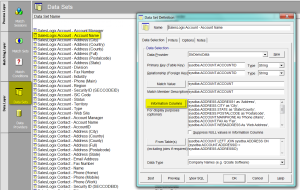| Summary: | When determining which record should be the primary member of a duplicate group, keeping the contact with most history or the account with most contacts is frequently the preference. These types of counts can be exposed in the Information Columns. |
| Article Type: | How-To Guide |
| Related Product(s): | This article relates to the following products:
|
For the reviewers of Paribus Discovery Match Results having information columns that speed up the decision are important. The information columns displayed are controlled in the Data Set.

As well as adding standard fields the information displayed can be enhanced further.
Adding Counts
When determining which record should be the primary member of a duplicate group, keeping the contact with most history or the account with most contacts is frequently the preference. These types of counts can be exposed in the Information Columns.
Note: It is also preferable to have the record with the most associated records as the primary member for processing purposes during a merge.
A SQL statement can be included within the Information column definition to provide a count of associated records.
An example SQL statement is below:
(SELECT COUNT (CONTACTID) FROM CONTACT WHERE CONTACT.ACCOUNTID = ACCOUNT.ACCOUNTID) As ‘Number of Contacts’
The Data Set would appear as example image here.

Resulting in a more informed view of the potential duplicate.

| Related Resources: | |
| Further Information: |

